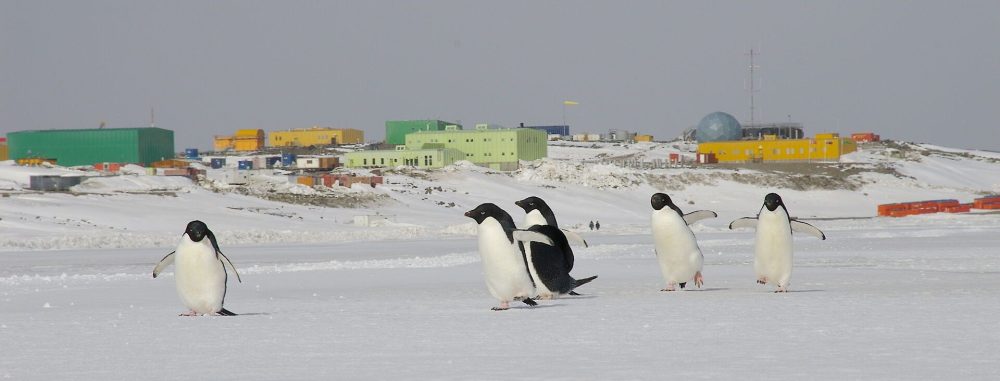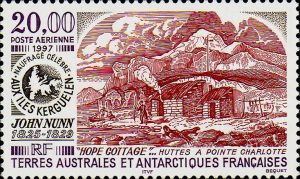 |
 While waiting two years and three months to be rescued when their sloop Favorite was shipwrecked at Kerguelen in 1825, the British sealer and cartographer John Nunn and his crew spent some miserable months trying to survive on Saddle Island (now called Ile de l’Ouest) at 49°17’59” South, 70°31’56”
While waiting two years and three months to be rescued when their sloop Favorite was shipwrecked at Kerguelen in 1825, the British sealer and cartographer John Nunn and his crew spent some miserable months trying to survive on Saddle Island (now called Ile de l’Ouest) at 49°17’59” South, 70°31’56”
East, buffeted by the merciless westerly winds.
Nunn concluded that there was a better chance of being discovered on the southeastern part of Grande Terre, the main island, so his group gradually skirted the southern coast in search of a place to settle in. (Image above is extracted from page 148 of Narrative of the Wreck of the “Favourite” on the Island of Desolation: detailing the adventures, sufferings and privations of J. Nunn, an historical account of the Island, and its whale and seal fisheries, by NUNN, John. Original held and digitised by the British Library. )
After passing Shoal water Bay (now called Baie Norvégienne), they were eventually able to find an area suitable for monitoring passing ships at Long Point (now called Pointe Charlotte) on the East coast of Courbet Peninsula, where they built two comfortable cabins which they baptized Hope Cottage.
 The group was finally spotted in 1827 by Captain Alexander Distant on the schooner Sprightly, belonging to the celebrated shipowner Enderby of London. Nunn and his crewmates joined the Sprightly in hunting whales and elephant seals until 25 March 1829, at which point they were finally returned to Harwich, England four years after the shipwreck.
The group was finally spotted in 1827 by Captain Alexander Distant on the schooner Sprightly, belonging to the celebrated shipowner Enderby of London. Nunn and his crewmates joined the Sprightly in hunting whales and elephant seals until 25 March 1829, at which point they were finally returned to Harwich, England four years after the shipwreck.
In 1997, the French post office issued a 20-franc air mail stamp to commemorate the shipwrecks and the construction of Hope Cottage.
Thanks and credit: Kerguelen Islands, French Southern and Antarctic Lands (Part 1) – Iles Kerguelen, TAAF (discoverfrance.net)
 En attendant deux ans et trois mois pour être secouru lorsque leur sloop Favorite fait naufrage à Kerguelen en 1825, le chasseur de phoques et cartographe britannique John Nunn et son équipage ont passé de misérables mois à essayer survivre sur Saddle Island (maintenant appelée Ile de l’Ouest) à 49°17’59’ Sud, 70°31 ’56’
En attendant deux ans et trois mois pour être secouru lorsque leur sloop Favorite fait naufrage à Kerguelen en 1825, le chasseur de phoques et cartographe britannique John Nunn et son équipage ont passé de misérables mois à essayer survivre sur Saddle Island (maintenant appelée Ile de l’Ouest) à 49°17’59’ Sud, 70°31 ’56’
Est, buffé par les vents impitoyables de l’ouest.
Nunn a conclu qu’il y avait de meilleures chances d’être découvert dans la partie sud-est de la Grande Terre, l’île principale. Son groupe a donc progressivement contourné la côte sud à la recherche d’un endroit où s’installer. (Image ci-dessus est extrait de la page 148 du Récit de l’épave du « Favoris » sur l’île de la Désolation : détaillant les aventures, souffrances et privations de J. Nunn, un récit historique de l’île et de sa baleine. et pêche aux phoques, par NUNN, John. Original détenu et numérisé par la British Library. )
Après avoir traversé la baie Shoal Water (maintenant appelée Baie Norvégienne), ils ont finalement pu trouver une zone propice à la surveillance des navires de passage à Long Point (maintenant appelée Pointe Charlotte ) sur la côte Est de la Presqu’île Courbet, où ils ont construit deux confortables cabanes qu’ils ont baptisées Hope Cottage.
 Le groupe fut finalement repéré en 1827 par le Capitaine Alexander Distant sur la goélette Sprightly, appartenant au célèbre armateur Enderby de Londres. Nunn et ses coéquipiers rejoignirent le Sprightly pour chasser les baleines et les éléphants de mer jusqu’au 25 mars 1829, date à laquelle ils furent finalement renvoyés à Harwich, en Angleterre quatre ans après le naufrage.< /p>
Le groupe fut finalement repéré en 1827 par le Capitaine Alexander Distant sur la goélette Sprightly, appartenant au célèbre armateur Enderby de Londres. Nunn et ses coéquipiers rejoignirent le Sprightly pour chasser les baleines et les éléphants de mer jusqu’au 25 mars 1829, date à laquelle ils furent finalement renvoyés à Harwich, en Angleterre quatre ans après le naufrage.< /p>
En 1997, la Poste française a émis un timbre-poste aérien de 20 francs pour commémorer les naufrages et la construction de Hope Cottage.
Merci et crédit : Îles Kerguelen, Terres australes et antarctiques françaises (Partie 1) – Îles Kerguelen, TAAF (discoverfrance.net)
Info de la Source Publié * ICI
